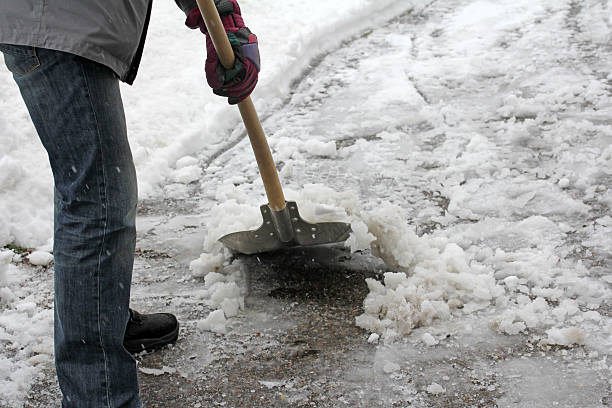Techniques for Effectively Shoveling Frozen Snow Off Your Property
For most of America, the prospects of snow is always awaited and celebrated by lovers of winter. And fresh, powdery snow is relatively easy to navigate on and remove if it isn’t more than six inches deep. What happens, though, when the snow that’s fallen freezes–hence turning it into the equivalent of a giant pile of slippery, unsmoothed cement poured all over your immediate outdoor walking space as well as everywhere else? Those scenarios are usually made of nightmares, especially in places around the U.S. where they aren’t used to harsh winters every year. Nowhere is that more the case than in the valley of Oregon where I’ve personally witnessed panic when the worst case winter scenario hits here.

Just a week prior to this writing, we had one of those rare winter storms (basically every 20-40 years) where you get a happy dusting of snow that then turns into a deep pile of slippery ice once the high temperatures stay in the 20’s for more than a week. When that happens, it also means your driveway and walkway will be coated with a half-foot layer of solid ice suitable for slipping on and breaking a leg. You’re also responsible by law to clean off your driveway and walkway or risk someone (think a lawsuit-hungry paperboy) slipping there and suing you for their medical expenses.
It is the same story every winter and this has become a routine that has to be followed once a year where cleaning the walkway has made it a practice to do the same everyday in the house for which we have appointed the best asphalt sealer for the job.
This means either going out and shoveling into that thick icy mess yourself or hiring someone to do it for you. If you’re young and healthy enough, shoveling away at that hardened ice can potentially be a good workout, even though it’s mandatory to use certain techniques in how you shovel the ice in order to avoid injury, no matter your age.
Any technique behind it should always have one major caveat attached: Don’t go out and shovel away at hardened snow if you’re known to have a heart condition or similarly if you’re in your elder years. Some older people might complain about the latter when some want to be independent or have to clear their driveways/walkways because they can’t afford to hire someone else to do it for them. Of course, shoveling the hardened snow could be dangerous for anybody at any age if you haven’t had a physical for a while. The important thing is to use your body in certain ways to avoid physical pain or the potential of instigating a heart attack.
The most important technique to use when you dig that shovel into the ice to scoop out a huge chunk is to lift it with your legs. So many people unwisely bend over when shoveling the hardened snow and can bring on serious back injury considering this is obviously heavier than ordinary snow would be. It’s also a good idea to keep your back straight not only when you lift the ice, but also when you’re jamming the shovel into the hardened snow to scoop a piece out. If the hardened snow is only a couple of inches thick, you can generally just slide the shovel underneath for a short distance to get a larger amount to toss to the side (as I did recently to clear ice off my walkway).
And, yes, the amount you put on the shovel makes a big difference. In shoveling regular snow, it’s always advised to just toss it to the immediate side rather than lifting a large amount more than a foot away. It doesn’t matter where you toss the piles of hardened snow, just as long as you create a clear enough path for people to walk on safely. In fact, it’s sometimes advised to just push snow to the side rather than lift it. When dealing with hardened snow, however, you’ll have to dig, like it or not. Just toss it a few inches to the side on sidewalks and less than a foot away on your driveway.
When digging that hardened snow, keeping your hands at a considerable distance on the shovel always helps create a more agile ability to handle larger amounts on the shovel. But as I insinuated above, the amount of the hardened snow you scoop shouldn’t be large, particularly when digging when it’s deep. To be safe, take no more than what fills the space of your shovel rather than a huge chunk overlapping. Yes, I know that time is short and you’ll want to shovel huge amounts to get the task done. Nevertheless, you’re probably trapped at home all day anyway if there’s deep frozen snow on the ground, so be judicious and patient in getting rid of it around your home.

These techniques should help you make headroom in getting rid of dangerous hardened ice around your property that frequently doesn’t get reported enough as being more of a problem in winter than snow. Be aware, too, that taking frequent breaks is essential, no matter how healthy you are. Those who keep going at it for two hours without breaks are asking for not only severe injury but risking that potential toward heart issues. While water may not sound appealing to consume during a time like that, take a break every ten to fifteen minutes and go inside to drink a glass to avoid dehydration.
Of course, if you’re able to find someone available, hiring someone to scoop hardened snow off your driveway and walkways shouldn’t be discounted. Just be sure to also provide a glass of water for them (coffee isn’t advised because it can increase heart rates), whether they want it or not. The only thing worse than personal injury while shoveling hardened snow is someone you hire getting hurt or having a heart attack.
Let’s hope that you’ll only have to shovel powdery snow and not hardened snow if you live in a town or city vulnerable to these kinds of winter storms. These kinds of storms, though, are the worst of the worst–unless you get snow up to above your rooftops. In those scenarios, at least you and everybody else will be trapped indoors and won’t have to worry about someone slipping outside your home on a dangerous and craggily ice rink…

